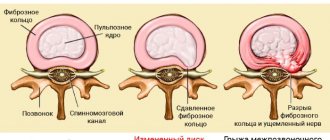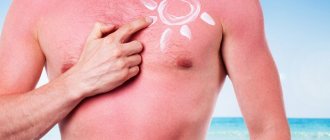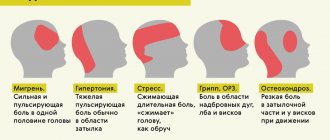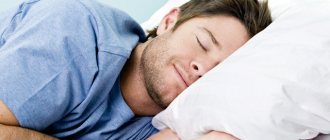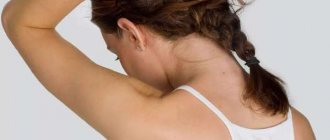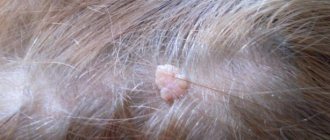Every cell of the human body has a connection with the nervous system - the ancient part of it, which we do not control, and the young cortex, which issues commands from consciousness. The message is carried out using nerve fibers, and they can exist normally if they are not under pressure from the outside and are not damaged from the inside. When such a situation does arise, it manifests itself as a sensation as if goosebumps are running down the skin. Then this symptom is not associated with the experience of any emotions and does not go away after switching to another thought.
Let us examine in more detail what this or that localization of these unpleasant sensations may mean, and what the duration of the “goosebumps” indicates.
Types and mechanism of “goosebumps”
The sensation of tingling and crawling is medically called “paresthesia.” They appear in response to irritation of nerve endings, the brain or spinal cord. The nature of this phenomenon is as follows: the sensitive nerve ending receives several different unrelated signals at once, layering on top of each other. As a result, the nerve does not know how to react correctly to this variety, and “turns on” numbness, burning, “pins and needles” or tingling.
Paresthesia is usually felt below the irritated area of the nerve. They may be accompanied by “goose bumps” - “pimples” in the area of hair growth, which is an analogue of the puffiness of fur or quills in animals.
Paresthesias can be:
- temporary, occurring when sitting in an uncomfortable position, freezing, sexual arousal, a feeling of euphoria from listening to music or when negative emotions appear. They are usually described as “pins and needles on your legs” and go away when the irritating factor stops. Not accompanied by cramps, pain or sensory disturbances;
- chronic, recurring. They are signs of the disease, and can be accompanied by two types of symptoms:
- indicating damage to the nerve fiber. These are: numbness in the limbs or only in the fingers, tingling sensation, goosebumps. Sometimes local twitching (convulsions) develops here;
- indicating damage to those nerves that are connected to the vessels of this area. This is evidenced by: pale skin, deterioration of temperature and pain sensitivity, cool temperature, hair loss.
Transient (temporary) paresthesia is a variant of the norm and does not require medical intervention. If “goosebumps” run without any visible effect on the skin, you definitely need to look for their cause and eliminate it.
How to get rid of this feeling
If the condition is caused by natural causes, then it will go away quite quickly on its own, without causing unnecessary and long-term discomfort. If goose bumps are a sign of a disease, then it will be possible to finally get rid of the problem only after curing the underlying disease that provokes it. There are no special procedures to eliminate this symptom, since it does not cause extremely unpleasant sensations, however, the doctor may prescribe sedatives to calm the nervous system.
What diseases provoke paresthesia?
The causes of goosebumps are varied. Let's list them first:
- osteochondrosis;
- damage to nerve fibers of various localizations - neuropathy;
- high blood glucose levels;
- impaired nutrition of nerve fibers due to diabetes mellitus, poisoning, including chronic alcohol intoxication - polyneuropathy;
- low blood levels of calcium or magnesium;
- nerve fiber injury;
- damage to nerve fibers by antibodies;
- varicose veins;
- migraine;
- Raynaud's syndrome;
- atherosclerosis of arterial vessels;
- insufficient intake of vitamins B1, 6, C;
- arthritis;
- restless legs syndrome;
- tumors of nerve fibers;
- tumor in the parietal lobe of the brain;
- autoimmune vascular damage - vasculitis;
- insufficiency of parathyroid gland function – hypoparathyroidism;
- neurasthenia;
- obliterating endarteritis;
- multiple sclerosis;
- trigeminal neuralgia;
- stroke;
- taking certain medications;
- shingles;
- rabies;
- follicular hyperkeratosis;
- entry of the filling mass into the canal of a tooth with a living nerve;
- damage to the nerve ending during tooth extraction.
If “goose bumps” is the name given to the external manifestation – “goose bumps”, without any other symptoms, then this pathology is called follicular hyperkeratosis.
Here, due to poor nutrition of the skin or constant irritation, the upper layer of the skin thickens excessively, and the mouths of the hair follicles become inflamed. Dermatocosmetologists treat pathology with various local and systemic means.
Goosebumps on the body, arms and legs
This symptom is accompanied by many diseases. Let's consider the main ones in more detail.
Hypovitaminosis B1
Vitamin B1 is needed for the normal functioning of the nervous system. It is involved in the production of acetylcholine - a substance that allows a nerve impulse to reach the muscle, intestines, sweat gland, heart - and transmit its command to it. Its insufficient intake from food or acceleration of its breakdown leads to:
- feeling of pins and needles on the legs and arms;
- irritability;
- headache;
- memory impairment;
- constipation;
- increased heart rate;
- pain in the heart;
- swelling;
- shortness of breath;
- sometimes even paralysis and cardiovascular failure.
Such symptoms require prompt diagnosis and treatment: administration of synthetic vitamin thiamine and diet correction.
Hypoparathyroidism
This is a reduced function of the parathyroid glands, in which the level of calcium in the blood decreases. It manifests itself not only as goose bumps in the limbs, but also:
- painful contractions of the muscles of the limbs, body and face: the arm is brought towards the body, it is “bent” at the wrist and elbow joints, the corners of the mouth are lowered, the eyelids are lowered by half, the body is arched back;
- swallowing is paroxysmally impaired;
- there is a stabbing pain in the abdomen;
- there may be vomiting, diarrhea;
- fainting occurs;
- twilight vision is impaired;
- "pawns ears;
- there are pains and interruptions in the heart;
- hair becomes thinner, the number of hair shafts falling out increases;
- the skin is peeling;
- a large number of teeth are affected by caries;
- nails become dull;
- With prolonged absence of therapy, cataracts develop.
Decreased calcium levels
Here the same symptoms develop as with hypoparathyroidism, but they are not as pronounced and occur more easily. Often, the pathology is manifested only by painful spasms of the muscles of the limbs and face, which immediately follow goosebumps, increased heart rate, trembling and recurrent vomiting. With an extremely low level of this electrolyte in the blood, difficulty breathing may develop until it stops, and painful arching of the entire body.
Low blood magnesium levels
This condition manifests itself:
- weakness;
- lack of appetite;
- nausea, vomiting;
- trembling of the body or individual muscles;
- Convulsions may occur in which the entire body contracts or arches. This is most common in children.
Taking medications
The appearance of goose bumps can be caused by taking drugs such as: Ofloxacin, Protionamide, Isonazid, Cycloserine, drugs against epilepsy and blood pressure lowering drugs.
Arrhythmias
In the case of the development of attack-like (paroxysmal) rhythm disturbances, a person may notice:
- “goosebumps” running over the body;
- chills at normal body temperature.
This state lasts from ten minutes or more; most often develops at night.
Brain stroke
Paralysis or partial immobility of the limbs on one side may be preceded by a feeling of numbness and crawling, sometimes on the opposite side. There is also a headache, there may be short- or long-term loss of consciousness, focal symptoms are observed: facial asymmetry, different widths of the palpebral fissures, inability to speak or understand speech.
Damage to the parietal lobe of the brain
A tumor or encephalitis that develops in the lobe responsible for sensitivity is accompanied by other symptoms: the inability to perform complex actions, failure to recognize objects if you close your eyes and feel them with your hands, loss of the ability to write. There may also be loss of half of the visual field and loss of awareness of one's own body diagram.
Guillain-Barre syndrome
This condition occurs after a viral infection (mainly colds and herpes), or intestinal infection caused by the Campylobacter bacterium or enteroviruses.
Here, in the period from 5 to 21 days after the illness, antibodies are formed to certain areas of the spinal nerve roots. This is manifested by the appearance of pins and needles on the legs, the range of movements gradually decreases, and sensitivity is impaired. The process may appear immediately on your hands. It may involve a certain volume, but may spread towards the chest. The last symptom is very dangerous and requires urgent hospitalization in the intensive care unit, as it can progress to respiratory arrest.
Head injury
A brain contusion can lead to the appearance of pins and needles on both one and two sides. After this, loss of sensation may develop.
Shingles
The disease is caused by the same virus as chickenpox; occurs in those who have already had it. It manifests itself as the appearance of goosebumps in the projection of any nerve, but more often - one of the intercostal nerves. Goosebumps precede the appearance of redness here, on which bubbles with transparent contents soon appear. The affected area burns and hurts.
Multiple sclerosis
This is an autoimmune pathology when one’s own antibodies begin to attack the membrane of most nerve fibers, as a result of which the latter become “naked” and begin to destroy themselves. There is no clear sequence or algorithm for damage to fibers, so it is difficult to recognize the disease.
Most often, it begins with deterioration of vision in one eye, the sensation of a foreign body in it, and the appearance of blurred contours of the objects in question. This condition lasts about a week, then goes away on its own, but not completely. Subsequently, the symptom will recur. Gradually, it leads to disruption of coordinated eye movements and a change in the normal reaction of the pupils to light. Usually, after this, goosebumps and pain appear on the face, which is the basis for making a diagnosis of “Facial neuritis” or “Trigeminal neuralgia”. Later, loss of coordination, changes in handwriting, and transient trembling of objects develop.
Also, the initial manifestations of the disease include goosebumps, burning, numbness or tightening of the skin that occurs on any part of the body. It goes away on its own and often does not serve as a reason to contact a neurologist or therapist.
Polyneuropathy
This disease is characterized by damage to the peripheral nervous system due to poisoning (including alcohol surrogates), metabolic disorders (mainly due to diabetes mellitus). It is dangerous because the disconnection of nerves, starting from distant parts of the body (fingers and toes), spreads closer and closer to the respiratory muscles, and can also involve the nerves that command the contraction of the muscles responsible for breathing.
Polyneuropathy manifests itself as a deterioration in the motor activity of the legs and arms, starting with the fingers, the appearance of goosebumps and numbness in these areas, and the gradual “turning off” of sensitivity in the areas of socks and gloves.
What are the most common complications after ARVI?
Sinusitis
Paranasal sinuses (sinuses) are small cavities behind the facial bones of the skull, which are located on both sides of the nose, under the eyes, under the eyebrows. Viral infections create favorable conditions for infection of the sinus mucosa with bacterial flora. Facial pain, difficulty breathing and impaired sense of smell, purulent discharge from the nose - these are the main symptoms of sinusitis. The main task of treating sinusitis by an otolaryngologist is to suppress bacterial inflammation and restore drainage of the paranasal sinuses.
Laryngitis, pharyngitis
This is an acute inflammation of the mucous membrane of the larynx and pharynx. The voice is hoarse or has disappeared altogether, the throat is sore and scratchy, there is general malaise. If you look into your mouth with a mirror, you can see a bleak picture: the mucous membrane of the pharynx is bright red, covered with mucus or individual granular follicles, the small tongue is swollen and red, the vocal folds are thickened and inflamed. Pharyngitis is treated with plenty of non-hot drinks, rinses, and warm foot baths. It is better not to strain your voice and it is advisable not to smoke. Avoid spicy foods for a while.
Otitis, eustacheitis
Inflammation of the middle ear and eustachian tube is manifested by decreased hearing, a feeling of fullness, and a sensation of fluid in the ear. When coughing, sneezing, especially when blowing your nose inappropriately, bacteria enter the middle ear through the auditory tube. Otitis media, which complicates the course of influenza, is severe, with severe intoxication and severe ear pain. Treatment is aimed at fighting the infection and restoring the patency of the auditory (Eustachian) tube.
Tracheobronchitis, bronchitis
Inflammation begins with a viral lesion and is then supported by bacterial flora. If your cough does not go away or you have shortness of breath, be sure to seek treatment from a specialist! Untreated bronchitis threatens to develop pneumonia (pneumonia) in the future.
Pneumonia
This diagnosis means that the inflammatory process in some area has affected the thinnest, most delicate pulmonary vesicles, the alveoli, and has made it difficult for them to work - saturate the blood with oxygen and free it from carbon dioxide. Pneumonia begins acutely - with a sudden deterioration in health, an increase in temperature. It’s time to recover from a cold, but then night sweats, chest pain, and shortness of breath appear. Pneumonia is treated with antibiotics, in serious cases - in a hospital.
Colds are often accompanied by shortness of breath, heart failure, and weakness. An acute respiratory viral infection (especially influenza) can also be complicated by polyneuritis, simultaneous inflammation of several nerves. You may also experience sensory disturbances in the arms and legs, muscle weakness, a pins and needles sensation, and even poor coordination.
Adequate treatment, adherence to the regimen, and careful taking of medications prescribed by a doctor will help prevent the development of complications of acute viral diseases.
Don't take colds lightly!
Advice from an otorhinolaryngologist
- If you are sick with ARVI, it is better to stay at home. Firstly, the body needs rest in order to tune in to recovery, and secondly, you are now contagious to others!
- Vasoconstrictor drops cannot be used independently for more than 5 - 7 days. If it is necessary to treat a runny nose longer, vasoconstrictor drops should be replaced with astringents;
- It is recommended to instill the drops in a lying position with the head thrown back;
- learn to blow your nose correctly. This should be done without much effort, through one half of the nose, to avoid nasal secretions from entering the auditory tube;
- in the room where the ARVI patient is located, moist air should be maintained;
- In order for the course of acute rhinitis to be short-lived, it is necessary to use thermal, distraction and diaphoretic procedures from the first days, as well as use local antibacterial agents.
Source: hospital-cs.ru
Goosebumps on the face and hands
If goosebumps crawl on the skin of your face and hands, this may be one of the following pathologies.
Migraine
At first, goosebumps appear on the face (especially around the mouth) and hands, then a headache develops mainly in one half of the head. In this case, paresthesia should be regarded as a migraine aura - a condition that precedes an attack of pain.
Tumor or inflammation of the frontal lobe of the brain
A change in personality (a person becomes “not the same as usual”) along with goosebumps in the lips and fingers may indicate damage to the frontal lobe. Only a neurologist can refute such a diagnosis, sometimes only on the basis of an MRI of the brain.
Goosebumps: diagnosis of the disease
As has already become clear, paresthesia is most often a symptom of an existing disease, so by recognizing such a body signal in time, you can correctly identify the disease and prevent possible complications.
To understand that goosebumps are not just the body’s reaction to any impressions, temperature changes, etc., answer yourself the following questions:
- “How often do you get goosebumps?”
- “What causes goosebumps?”
- “Are goosebumps accompanied by pain in the body, and does this worsen my health?”
- “Were there any signs of goosebumps before?”
- “Is the appearance of goosebumps related to drinking alcohol?”
- “Are there any significant changes in body temperature?”
- “Isn’t the sensitivity of the skin lost when goosebumps appear?”
Listen to your feelings
If you feel goosebumps quite often, and you feel some changes in your health, for example, you temporarily stop feeling your arm, leg, etc., do not delay visiting the doctor. Most likely, in this case, the symptoms are a sign of some kind of disease.
The doctor will study your medical history, interview you and, based on this, refer you for the necessary examinations and tests, as well as for consultation with a specialized specialist.
Goosebumps on the scalp
If you have goosebumps on the back of your head, it could be:
- Neuropathy of the greater occipital nerve. At the same time, goosebumps, numbness and tingling are felt in the area of the back of the head to the crown; here there is increased or decreased sensitivity. You can find pain points in the back of the head.
- Neuropathy of the cervical plexus with compression of its sensory nerves. Here in the area of the back of the head, neck, shoulder girdle and behind the ear, pain and goosebumps are felt.
- Transient ischemic attack (ministroke). In this case, the tingling sensation is felt for 1-2 hours, then disappears, leaving no focal changes.
- Bell's palsy. At first, goosebumps are felt on one side of the face, after which weakness of the muscles on this side appears, and then they completely cease to provide movement to one side of the mouth and facial muscles.
Reviews
Irina: My frequent goosebumps turned out to be a symptom of occipital nerve neuropathy. I didn’t even think that such a harmless manifestation could be a sign of illness.
Lisa: I’m a nervous person; any unexpected touch gives me goosebumps. To somehow improve my condition, I periodically drink valerian.
Serezha: Goosebumps often happen when you have a cold, the doctor said that this is a completely normal skin reaction.
Yana: I often had goose bumps on my head. It turned out that there were problems with the thyroid gland. After treatment, all symptoms disappeared.
Source: myadvices.ru
Goosebumps on your hands
If you notice goosebumps crawling on your arm, please note: this may be due to the following reasons.
Anterior scalene syndrome
When this muscle is overstrained, which is caused by compression of the lower trunk of the brachial plexus and the subclavian artery, pain and pins and needles are noted in the arm - from the shoulder to the little finger and ring finger. When turning the head, the pain radiates to the back of the head and chest. There may be numbness and chilliness in the hand, and the skin becomes pale or more bluish.
Brachial plexus syndrome
It is characterized by deterioration of movement in the hand, goosebumps and decreased sensitivity in the part of the hand that is located on the little finger side.
Raynaud's disease
Manifested by coldness and paleness of the fingers. Goosebumps crawl over them, the fingers first turn blue and begin to hurt, then their skin turns red, and the pain subsides. Often not only the fingers, but also the toes are affected.
Osteochondrosis, trauma, spondylolisthesis or tumor of the cervical spinal cord
These diseases are characterized not only by the appearance of goose bumps in the hands, but also by pain in the muscles of the hands, a gradual decrease in strength in their muscles, and a deterioration in temperature and pain sensitivity in the hands. If a pathological process (tumor, edema or vertebrae) compresses the vessels leading to the brain, dizziness, hearing or vision impairment will occur.
Myositis of the cervical muscles
Goosebumps in the arms are accompanied by pain in the neck. These symptoms are worse in certain positions of the neck. Read more about myositis.
Costoclavicular syndrome
This is the name for compression of the vessels and nerves of the brachial plexus, which occurs in a vertical position if the shoulder girdle is pulled back and down (for example, when carrying a heavy backpack). In this case, pain when standing at attention, accompanied by goosebumps, develops along the inside of the hand and forearm.
Musculocutaneous nerve neuropathy
This nerve gives commands to many muscles of the shoulder, including the biceps, reaching the forearm, it is divided into anterior and posterior branches. If the nerve is pinched at the level of the elbow fold, pain occurs in this place, which radiates to the side of the forearm and is accompanied by a burning sensation and goosebumps. The pain intensifies with flexion and extension of the elbow, and rotation of the forearm in and out.
Compression of the median nerve in the axillary fossa
The pathology occurs mainly when carrying heavy objects resting on the armpit, as well as when spouses sleep together, when the head of one of them is under the arm of the other.
Here goosebumps run across the palm; at first this is not accompanied by pain or dysfunction. If a similar situation with compression is repeated, the work of the flexor muscles of the palm and those muscles that are responsible for flexing the thumb and index fingers worsens. The palm loses its sensitivity; the muscles that form the eminence of the thumb are hypotrophied.
Intermetacarpal tunnel syndrome
This is the name of the condition when the nerve is pinched by the heads of the metacarpal bones. Symptoms: numbness and pins and needles in the area of the surfaces of the fingers facing each other, which intensify with flexion and extension of the fingers.
Pinched nerve between the heads of the triceps muscle
The causes of the condition are injury to the back of the arm, fracture of the humerus.
Symptoms: deterioration or inability to straighten the hand; if you press on the back of the forearm, pain and pins and needles appear near the thumb.
Compression of the dorsal branch of the ulnar nerve
This occurs due to the habit of resting your elbow on the edge of the table. Pain occurs on the inside of the hand. If you press on the inside of the wrist, the pain intensifies and a pins and needles sensation appears.
Goosebumps on my feet
The symptom of goosebumps “running” down the leg is caused by various conditions. Let's look at the main ones.
Lumbar plexus neuropathy
It appears due to compression of the plexus by altered upper lumbar vertebrae, hematomas, abscesses, phlegmons, and tumors in this area.
Symptoms: pain and pins and needles - in the lower abdomen, in the pelvic area, on the thigh. They intensify when the extended leg is raised upward.
Varicose veins
The legs, especially when standing for a long time and at the end of the working day, itch, swell, and feel heaviness. Dilated veins and purple vascular networks are visually identified.
Restless legs syndrome
This is the name of a condition caused by various reasons, when a burning, tingling, feeling of bursting or squeezing is felt in the legs, due to which the lower limbs perform a frequent reflex movement of “throwing off”.
To clarify and eliminate the cause of such sensations, contact a therapist and neurologist.
Bernhardt-Roth disease
It manifests itself:
- goosebumps, burning, numbness, tingling in the area from the hip joint along the anterolateral surface of the thigh to the knee;
- pain and pins and needles intensify when walking, disappear if you sit or lie with your legs bent;
- if you touch the skin in this area, it will hurt, you will feel a feeling of heat, a prick;
- sensitivity here is increased;
- There may be both dry skin and increased sweating in this area.
After lumbar puncture
Injury to the nerve roots during lumbar puncture can lead to pain, loss of sensation in the legs, and weakness in their muscles.
Operations on the spinal cord, spinal nerves, spine
If the nerve roots were injured during the intervention, the following occurs:
- goosebumps in the legs;
- weakness of the leg muscles;
- decreased sensitivity in the legs.
Raynaud's disease
It manifests itself as pain and coldness of the fingers, then the fingers turn blue, which is accompanied by increased pain. Then the vascular spasm goes away, the fingers turn red, and the pain and goosebumps go away.
Femoral nerve neuropathy
It can be caused by a fracture of the pelvic bones with bleeding into the muscles surrounding this nerve. It may occur if the nerve was injured during puncture of the femoral artery, or if it was compressed by lymph nodes or a hematoma localized in the area of the inguinal fold.
Symptoms:
- pain – in the groin area;
- spreads to the lumbar region, to the thigh and lower leg along their anterior internal surface;
- Here goosebumps are detected and sensitivity is reduced;
- flexion-extension of the hip and knee may be performed in too small a volume;
- climbing stairs is especially difficult.
Clamping of the saphenous nerve
Pins and needles, pain and loss of sensitivity are determined along the inside of the leg from the knee to the big toe.
Rabies
The disease occurs as a result of the bite of an infected animal, which introduces the rabies virus into the wound. Pathology manifests itself as the appearance of goosebumps in the bitten leg. Subsequently, fear of light, water and sound develops.
Goosebumps: types
Goosebumps are classified according to different factors:
- Temporary. Such paresthesias include those that arise due to prolonged stay in an uncomfortable position, for example, at night while sleeping, tucking your leg under you or putting your hand under the pillow, listening to pleasant music, watching your favorite movie, feeling horror, fear, due to sudden change in room temperature. Goosebumps that appear for the above reasons can be called safe, since they do not harm health, do not cause pain and do not require treatment.
There are several types
- Chronic. They can also be called periodic, since they appear from time to time and are a symptom of a developing disease. Such paresthesias are certainly considered dangerous. Most often, such goosebumps are accompanied by muscle pain, cramps, numbness of the limbs, etc.
- Paresthesias of the upper and lower extremities, trunk, face, tongue, head, and back also differ
Goosebumps on the tongue
This is typical for:
- rubbing with dentures;
- changes in bite resulting from the removal of one or several teeth;
- galvanization, when an electric current occurs due to the fact that the crowns are made of different metals;
- getting filling material into the canal;
- hypovitaminosis B12;
- damage to the sensory fiber of the glossopharyngeal nerve;
- inflammation of the arachnoid membrane of the brain;
- peptic ulcer of the upper digestive system;
- diseases of the ENT organs: sinusitis, rhinitis.
Goosebumps in the back area
Goosebumps “run” down the back when there is a pathology of the spine, such as spondylosis. If the vertebrae in the cervical region are deformed, then goosebumps and pain will be felt in the neck, crown and upper back; they intensify with certain movements. If similar symptoms develop in the thoracic region, we are most likely talking about spondylosis or osteochondrosis of the thoracic region. Finally, in pathologies when the nerves coming from the lumbosacral region are pinched, goosebumps will be felt in the lumbar region.
What to do if you have goosebumps on your head
You should not immediately panic if goosebumps appear on your head, because this is most likely a natural reaction of the body to a psycho-emotional state or external influence. In this case, the sensation will quickly pass and will not be systematic. If the origins lie in increased excitability of the nervous system, then you can take mild sedatives - for example, Glycine, mint tea or aromatherapy with mint or lavender oils. A massage of the back and neck will improve your overall well-being, because often headaches, irritability and increased nervous sensitivity are a consequence of the accumulation of salts in the cervical region.
A person's attention should be drawn to the pathologically frequent appearance of goosebumps and their presence for a long time. In this case, most likely the problem lies in the presence of a disease, which cannot be determined without a visit to the doctor and a series of examinations. It is worth considering that symptoms similar to osteochondrosis (headache, irritability, etc.) can also develop with deviations in the normal functioning of the thyroid gland. Consultation with a specialist is necessary if you have the following symptoms:
- numbness and goosebumps do not stop for more than an hour;
- along with goose bumps on one part of the head, its immobilization is observed;
- Along with goose bumps, there is pain in the head and high blood pressure;
- the condition is accompanied by functional disorders (hearing, vision, etc.);
- in the goose bump area there is a change in skin temperature and it turns red.
Without making a diagnosis, it is impossible to take any measures, since, for example, the same massage for problems with the thyroid gland or back injuries is most often contraindicated.
Algorithm for analyzing the state when “goosebumps” appear
Before you panic, remember what caused the paresthesia. It is also important to assess your condition as objectively as possible and notice additional symptoms:
| Then the goosebumps appeared | Where are they felt? | Additional symptoms | What could it be | Which doctor should I contact? How to confirm? |
| After a spinal injury | In the limb area | Numbness, impaired sensitivity and movement in the limbs. With a cervical injury, there may be dizziness and loss of coordination. No goosebumps | Fracture, fracture-dislocation of vertebrae | Neuropathologist X-ray or computed tomography of the spine in the injured area |
| For no reason, but more often - if a person suffers from thrombosis, arrhythmias, hypertension | In the area of one half of the body | Sudden onset of poor sensitivity and inability to move the arm and leg on one side | Stroke | Neuropathologist Examination by an ambulance doctor, a neurologist, computed tomography of the brain performed under the supervision of a resuscitator |
| For no apparent reason | In the area of the limbs, but not on one side of the arm or leg, but grabbing either the foot (hand), or the foot and lower leg (hand and forearm), or the entire limb | Numbness, pallor of the skin, decreased local temperature, hair loss or decreased growth in the area where the “pins and needles” sensation is felt | Poor arterial patency: obliterating atherosclerosis or obliterating endarteritis. There may also be nerve compression | Vascular surgeon, neurologist Ultrasound with Dopplerography of the arteries of the extremities (both). Examination by a neurologist, checking tendon reflexes, electroneurography |
| With frequent alcohol consumption | In the area of the extremities (lower, upper or all) | The same | Alcoholic polyneuropathy | Examination by a neurologist, checking tendon reflexes |
| After an arm/leg injury | In the area of injury, above and below the point of impact | Feeling of “pins and needles”, decreased or increased sensitivity to cold/heat, muscle weakness of only this limb | Nerve fiber injury | Examination by a neurologist |
| After working with paints or heavy metals | Legs, arms | “Goosebumps” on the extremities (usually the legs), while sensitivity in the toe area decreases, and the muscles there become weak. Weakness and decreased sensation may also be observed in the hands, in the glove area, and spread along the arms/legs towards the torso | Toxic polyneuropathy | Examination by a neurologist, determination of sensitivity and tendon reflexes |
| If you have diabetes | In the area of both or four limbs | “Goosebumps” on the legs/arms, decreased sensitivity, muscle weakness | Diabetic polyneuropathy | Endocrinologist together with a neurologist Blood test for sugar (glucose) level, glycated hemoglobin level, electromyo- and electroneurography |
| For no apparent reason | In the area of the lower/upper or all 4 limbs | Changes in temperature and pain sensitivity, cold skin, muscle weakness | Vitamin deficiency (most likely B1) | Therapist – for adults, pediatrician – for children Examination by a neurologist, determination of the level of vitamins in the blood |
| During pregnancy | In the leg area | There are signs of pregnancy. There may be night cramps | Lack of magnesium or calcium | Therapist Determination of calcium and magnesium in blood |
| For no apparent reason | Both on the body and on the limbs | A persistent low fever that does not decrease with antibiotic treatment, but goes away on its own. Often - spots on the skin, there may be a “mesh pattern”. Losing weight. Pain in muscles, joints | Vasculitis | Therapist, rheumatologist Rheumatology tests, LE cells and other tests prescribed by a rheumatologist |
| Against the background of the same type of work | In a separate area of the limb (less commonly, the body) | Pain in this area, loss of sensitivity, “pins and needles”. Pass through time | Pinching or inflammation of a single nerve fiber | Neuropathologist Examination by a neurologist, determination of sensitivity and tendon reflexes |
| After a cold, intestinal infection, vaccination, surgery | It starts from the feet, can end there, and can rise, capturing the legs, thighs, hands, and forearms. Breathing, swallowing, and regulation of vascular tone may be impaired | Numbness, loss of sensitivity, muscle weakness, impaired movement of the limbs or their parts, up to paralysis, which can be treated if started in a timely manner. When immobilization of the limbs occurs, the “goosebumps” disappear | Infectious-allergic polyneuropathy (Guillain-Barré or Guillain-Barré-Landry syndrome) | Neuropathologist, sometimes together with infectious disease specialists Examination by a neurologist, determination of sensitivity and tendon reflexes |
| Either for no reason, or after suffering from acute respiratory viral infection | In any area, but more often - between the ribs | Chickenpox-type blisters are observed in the affected area. This is also accompanied by a burning sensation and pain when breathing | Herpes zoster | Infectious disease specialist together with a neurologist |
| For no apparent reason | Hands, face, mouth area | After goosebumps there is a headache, usually in one half of the head | Migraine with aura | Examination by a neurologist |
| After hypothermia | Separate area of the face | Pain in this area, lacrimation, increased sweating on this side | Trigeminal neuralgia | Examination by a neurologist |
| After an animal bite | At the site of the bite | Increased sensitivity of this area, sensation of a “twitching” muscle, photophobia, hydrophobia | Rabies | The diagnosis is made based on examination by an infectious disease specialist/radiologist |
| For no apparent reason | In any area | Accompanied by a completely different set of neurological symptoms: headache, loss of coordination, decreased vision, loss of sensitivity in any areas of the skin of the face, limbs, and torso | Multiple sclerosis, some mitochondrial diseases | MRI of the brain and cervical spinal cord with contrast, electroneurography, laboratory tests that will be prescribed by a neurologist after examination |
| For no apparent reason | “Goosebumps” appear in paroxysms on any part of the body, the location of which may vary. Most often they are felt in the back of the head | Distorted perception of one's own body parts, failure to recognize objects, inability to perform complex movements, loss of the ability to count and solve arithmetic problems. There may be loss of visual field | Damage (usually by tumor) to the parietal lobe of the brain | Neuropathologist MRI of the brain |
| After hypothermia of the head, overload of the neck muscles. Maybe for no apparent reason | In the back of the head | Severe pain in the back of the head, such as “drilling”, “shooting”, occurs in attacks. During the interictal period, a dull pain in the back of the head may remain. You can find points on the back of the head, pressure on which increases pain and goosebumps | Occipital neuralgia | Examination by a neurologist |
If you have goosebumps:
- run around the local area, especially in the limbs,
- this is not accompanied by disturbances of consciousness, vision, breathing, swallowing,
- does not rise to the respiratory tract,
it can be any of the neuropathies of numerous nerves. This diagnosis is made by a neurologist based on a routine examination of the patient. We will not list all the diagnoses in the table, especially since their treatment is the same.
The following important information regarding paresthesia should also be noted:
- the lower (closer to the toes) the area where the goose bumps are located, the closer to the tailbone the pathology is located;
- a large area of goosebumps running from a large (hip or shoulder) joint to the fingers indicates a pathology of the spine, while the reverse movement (from the fingers upward) indicates nerve damage;
- if sensitivity is impaired, pain appears and goosebumps appear in a small area between the hand (foot) and shoulder (thigh), most likely a small nerve fiber is damaged (compressed);
- pain that occurs along with goosebumps
- Goosebumps and sensory disturbances are especially dangerous in patients with diabetes, as well as after an intestinal or cold illness;
- anxiety and an urgent visit to a neurologist should be caused by conditions when, along with goosebumps, it is discovered that the affected area does not distinguish what kind of - sharp or blunt - object has touched it, and also does not distinguish between hot and cold water;
- You need to visit a neurologist or vascular surgeon if the skin where the goosebumps run has turned pale, cold, and has little pale hair growing on it.
What can cause goosebumps in children
Goosebumps in children can be caused by:
- Guillain-Barre syndrome;
- intoxication (due to diphtheria or poisoning) polyneuropathy;
- encephalitis affecting the parietal region;
- scalene muscle syndrome due to an accessory rib;
- neuropathies due to muscle spasms;
- vasculitis;
- arthritis;
- taking certain medications;
- spondylosis;
- lack of B vitamins;
- hypocalcemia or hypomagnesemia.
Author:
Krivega Maria Salavatovna resuscitator
